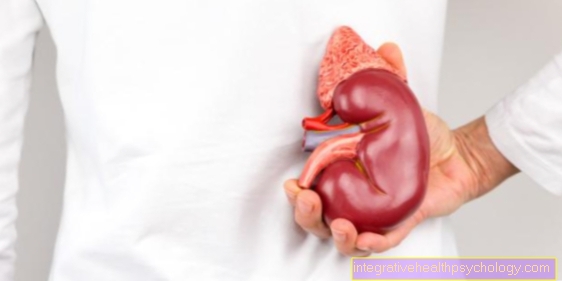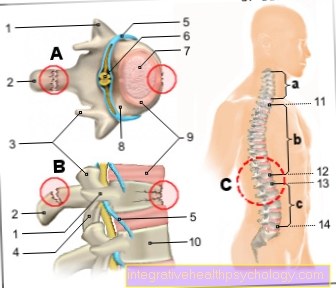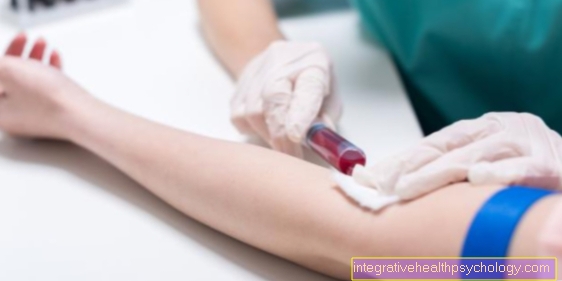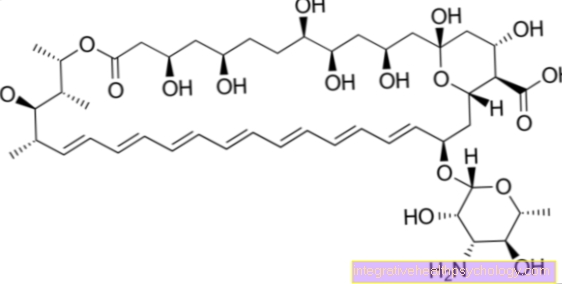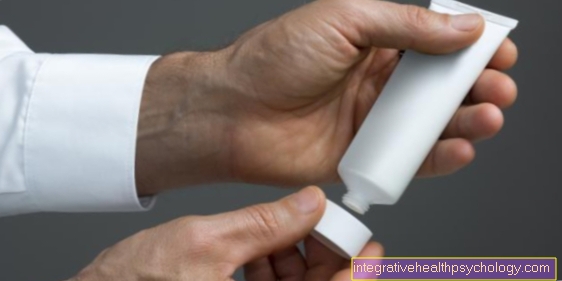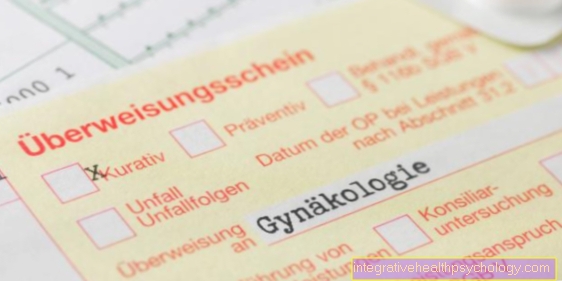Port access
definition
A port system or port is a catheter system that is built under the skin.
It serves as permanent access to blood vessels or body cavities, so that you do not have to constantly use a peripheral access (to a vein in the arm). The port system is punctured from the outside through the skin. The port is usually placed as a central venous catheter, i.e. on veins close to the heart, in order to administer infusions or the like more easily and to ensure safe access. Especially substances that would damage small veins in the long run can be administered better.

Indications
The most common indications are shown below as an overview.
- Chemotherapy for tumor diseases
- special drug administration
- parenteral nutrition
- Administration of blood or blood components
- Difficult vein conditions
There are many different indications for a port system.
The most common use of a port system is found in the treatment of tumor diseases, but other diseases that require frequent access to veins or arteries are also an indication. Indications for port system are, for example, chemotherapy that must be given via central infusions, Long-term parenteral (not through the gastrointestinal tract) nutrition and the administration of blood or blood components. In addition, there are certain drugs that can only be administered through the central venous system, i.e. close to the heart.
Furthermore, a port can be considered for patients with difficult vein conditions on the arms etc. in order to ensure safe access. Patients who are prone to complications when the access is outside the body can also get a port. Examples would be the formation of blood clots (thrombosis) and the infection of an access, for example in patients with a weakened immune system. There are also people for whom, due to anatomical structures, access via, for example, an arm vein is not possible.
More information can be found here:
- Blood transfusion
- Conducting chemotherapy
Laying the port
After the patient has been thoroughly informed, the port is placed in a small surgical procedure. Here only the port catheter, i.e. the tube with the connected chamber, is introduced into the body. The operation can be done with local or general anesthesia and usually takes 30 to 40 minutes.
First, the skin area around the chest is disinfected. An incision is then made below one of the collarbones showing one of the large veins, for example the subclavian or jugular vein. The catheter is then inserted into this vessel and advanced to the heart under image control.
Then, with the help of another incision, a pocket for the port chamber is formed in the fatty tissue of the skin. Various locations are suitable for this. Most often the chamber is implanted below the collarbone, but occasionally further down on the front chest or arm.
After several rinses and checking the position, the incisions are sewn and connected. The port can now be punctured with a port needle for the application of the medication from the outside.
Puncture sites
In principle, a port can be placed in all larger central veins.
The cephalic vein is most commonly used, a larger cutaneous vein on the upper arm. The catheter is inserted from here and the port chamber, which is later punctured, is installed under the skin in the area of the pectoral muscle and the first or second rib. Other veins that can serve as access are the great jugular vein (Internal jugular vein) or the clavicle vein (Subclavian vein). The port chamber is placed in the same place for all three accesses. That means the puncture site is always on the 1st or 2nd rib. Other approaches are the hepatic artery, the peritoneum or the epidural space (above the meninges). However, these are used for special questions and not the classic port.
Piercing the port
preparation
Before piercing a port, you must always check whether you have all the necessary materials that you need. These would be: disposable gloves, hand disinfection, skin disinfection, sterile disposable gloves, face mask, hood, sterile compresses, port needle, slit compress and sterile compress, leukoplast (plaster), two 10ml syringes filled with sterile saline solution, possibly 3-way stopcock, stopper, sterile Pad, disposal container and, if necessary, perforated cloth.
In addition, the patient must be informed about what one is doing and what complications there may be. The correct size of the port needle should also be estimated based on how deep the port is under the skin, and the patient can be asked which size is usually used. Hygienic hand disinfection should now be carried out and protective clothing (face mask, hood) should be put on. The materials should now be prepared on a sterile surface and the disposable gloves should be put on. If blood is to be drawn from the port, the blood draw materials must also be prepared. Now the puncture site must be found and examined for signs of infection (redness, swelling). The puncture site is then disinfected several times. Now the examiner takes off the disposable gloves and disinfects the hands, then puts on sterile gloves.
Also read our topic: Puncture
procedure
To pierce the port, the port needle with the attached supply hose and the syringe must first be vented with saline solution. Then the port needle is grasped with the dominant hand and the port is fixed with the non-dominant hand. The patient should be warned about the puncture. Now the needle should be pierced vertically and centrally into the plastic membrane of the port and pushed forward until it stops. Blood is drawn from the port to check that the needle is correctly positioned. Now the port is flushed with saline solution. The solution should be able to be injected without resistance. If the port can be used without any problems, it is now rinsed again with saline solution and a sterile stopper or a 3-way stopcock is applied as a closing cap. Then the port is connected with sterile compresses and stuck with plaster.
Lay time
A port needle can be used for 5-7 days, after which the needle must be changed. Depending on the manufacturer, a port can be pierced up to 2000 times.
Complications
In the following you will find an overview of the possible complications.
- Pain
- bruise
- Skin defects
- Infection of port parts
- Formation of a blood clot
- Blood poisoning
- Inflammation of the heart
Various complications can arise with a port system.
For example, a bruise (hematoma) can form in the port area or at the puncture site. In addition, if the port is punctured incorrectly, fluid can flow next to the vein and damage the surrounding tissue. If the puncture is incorrect, the catheter system can also be injured, making it leaky and no longer usable. If the wrong needle is used for the puncture, the membrane of the port may be defective and the port can no longer be used.
In addition, skin defects are possible through the puncture. Probably the most feared complications are the infection of parts of the port, such as the port pocket or the port itself and the resulting consequences, such as blood poisoning (sepsis) or inflammation of the heart (Endocarditis). Another serious complication is the formation of a blood clot (thrombus) in the port system if it has not been sufficiently flushed. Here the port can no longer be used because the vessel is closed.
You might also be interested in these topics:
- Symptoms of endocarditis
- Symptoms of blood poisoning
Pain at the puncture site
Pain at the puncture site can occur for a variety of reasons.
On the one hand, a small hematoma when piercing the port can lead to the pain, then a small bruise is usually also visible. Another cause could be infections in the port or a poorly positioned port system. A doctor should be contacted here in any case.
You may also be interested in this topic: Pain after a puncture
maintenance
The port needle must be changed regularly every 7 days.
The needle must be rinsed again and the puncture site thoroughly disinfected. The bandage should also be changed regularly and the puncture site checked to rule out any infections. This should take place every 2-3 days. It is also important to flush the port regularly, especially between the administration of various medications, after transfusions (blood) and nutritional infusions.
A port that is currently not in use should also be flushed every four weeks to prevent the port from becoming clogged.


